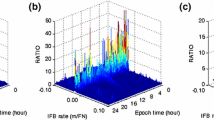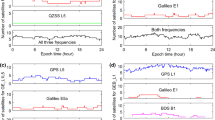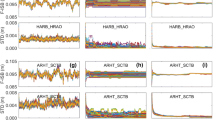Abstract
The carrier phase inter-frequency bias (IFB) of GLONASS between receivers of different types is usually not zero. This bias must be estimated and removed in data processing so that the integer double difference (DD) ambiguities can be fixed successfully. Recently, the particle filter approach has been proposed to estimate the IFB rate in real time. In this approach, the IFB rate samples are first generated and used to correct the phase IFB in the GLONASS observations. Then, the weights of the rate samples are updated with a function related to RATIO which is for ambiguity acceptance testing in integer ambiguity resolution. Afterwards, the IFB rate is estimated according to the weighted particles. This approach can estimate IFB accurately with short convergence time and without prior information. However, when the system noise is set too low, the estimated results are unstable due to the serious problem of particle diversity-loss, even though the system model is accurate. Additionally, the computational burden is dependent on the number of particles, which has to be optimized for the computation at hand. Therefore, this study proposes two improvements for the IFB estimation in regard to the above two aspects. The first improvement is to solve the noise setting problem by employing a regularized particle filter (RPF). The second improvement optimizes the number of particles in the resampling step according to the standard deviation (STD) of the weighted particles via a controlling function. The two improvements result in significantly better performances. The regularization method allows for the system noise to be set as zero without disturbing the estimates, and consequently, more precise estimates can be achieved. In addition, the approach using the controlling function for adapting the number of particles has comparable performance in precision but the computation load is largely reduced.









Similar content being viewed by others
References
Al-Shaery A, Zhang S, Rizos C (2013) An enhanced calibration method of GLONASS inter-channel bias for GNSS RTK. GPS Solut 17(2):165–173
Arulampalam S, Maskell S, Gordon N, Clapp T (2002) A tutorial on particle filters for online nonlinear/nonGaussian Bayesian tracking. IEEE Trans Signal Process 50(2):174–188
Closas P, Fernández-Prades C (2011) Particle filtering with adaptive number of particles. In: IEEE Aerospace Conference, pp. 17
Doucet A, Freitas N, Gordon N (2001) Sequential Monte Carlo Methods in Practice. Springer, New York
Euler H, Schaffrin B (1991) On a measure of discernibility between different ambiguity solutions in the static-kinematic GPS-mode. In: Proceedings of the international symposium on kinematic systems in geodesy, surveying, and remote sensing. Springer, New York, pp 285–295
Fox D (2003) Adapting the sample size in particle filters through KLD-sampling. Int J Robot Res 22(12):985–1003
Gordon J, Salmond J, Smith F (1993) Novel approach to nonlinear/non-Gaussian Bayesian state estimation. IEE Proc Radar Signal Process 140(2):107–113
Gustafsson F (2010) Particle filter theory and practice with positining applications. IEEE Aerosp Electron Syst Mag 25(7):53–82
Gustafsson F, Gunnarsson F, Bergman N, Forssell U, Jansson J, Karlsson R, Nordlund P (2002) Particle filters for positioning, navigation, and tracking. IEEE Trans Signal Process 50(2):425–437
Haug A (2012) Bayesian estimation and tracking: a practical guide. Wiley, New Jersey
Jiang W, An X, Chen H, Zhao W (2017) A new method for GLONASS inter-frequency bias estimation based on long baselines. GPS Solut 21(4):1765–1779
Liu Y, Ge M, Shi C, Lou Y, Wickert J, Schuh H (2016) Improving integer ambiguity resolution for GLONASS precise orbit determination. J Geodesy: 90(8):715–726
Pratt M, Burke B, Misra P (1998) Single-epoch integer ambiguity resolution with GPS-GLONASS L1-L2 Data. In: Proceedings of ION GPS, Institute of Navigation, Nashville, TN, September, pp 389–398
Tian Y (2016) Online estimation of inter-frequency/system phase biases in precise positioning. PhD thesis, Veröffentlichungen der DGK, C-782
Tian Y, Ge M, Neitzel F (2015) Particle filter-based estimation of inter-frequency phase bias for real-time GLONASS integer ambiguity resolution. J Geodesy 89(11):1145–1158
Tian Y, Ge M, Neitzel F (2017) Particle filter-based estimation of inter-system phase bias for real-time integer ambiguity resolution. GPS Solut 21(3):949–961
Wang J, Rizos C, Stewart M, Leick A (2001) GPS and GLONASS integration: modeling and ambiguity resolution issues. GPS Solut 5(1):55–64
Wanninger L (2012) Carrier-phase inter-frequency biases of GLONASS receivers. J Geodesy 86(2):139–148
Wanninger L, Wallstab-Freitag S (2007) Combined processing of GPS, GLONASS, and SBAS code phase and carrier phase measurements. In: Proceedings of ION GNSS 2007, Institute of Navigation, Fort Worth, TX, September 2007, pp 866–875
Yao Y, Hu M, Xu X, He Y (2017) GLONASS inter-frequency phase bias rate estimation by single epoch or Kalman filter algorithm. GPS Solut 21(4):1871–1882
Zhang S, Zhang K, Wu S, Li B (2011) Network-based RTK positioning using integrated GPS and GLONAS observations. In: International Global Navigation Satellite Systems Society Symposium-IGNSS, Sydney, Australia, 2011
Zinoviev A (2005) Using GLONASS in combined GNSS receivers: current status. In: Proceedings of ION GNSS 2005, Institute of Navigation, Long Beach, CA, September 2005, pp. 1046–1057
Acknowledgements
This work is supported by the State Key Laboratory of Geodesy and Earth’s Dynamics (Institute of Geodesy and Geophysics, CAS) (No. SKLGED2018-3-1-E), the National Natural Science Foundation of China (No. 41374002) and the Sichuan Provincial Science and Technology Program (No. 2015JQO046). Linguo Yuan is funded by National Program for Support of Top-notch Young Professionals.
Author information
Authors and Affiliations
Corresponding author
Rights and permissions
About this article
Cite this article
Tian, Y., Ge, M., Neitzel, F. et al. Improvements on the particle-filter-based GLONASS phase inter-frequency bias estimation approach. GPS Solut 22, 71 (2018). https://doi.org/10.1007/s10291-018-0735-9
Received:
Accepted:
Published:
DOI: https://doi.org/10.1007/s10291-018-0735-9




